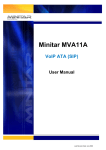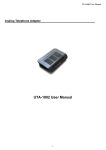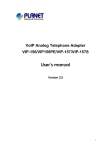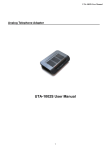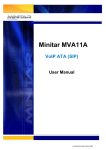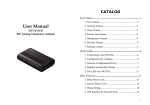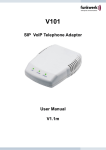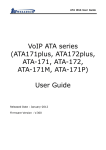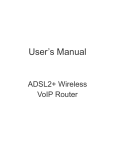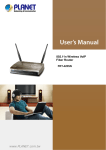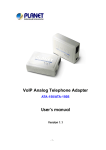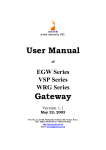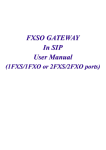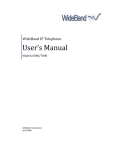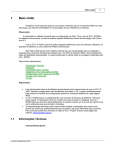Download User`s Manual
Transcript
User’s Manual VoIP ATA Index FCC Part 68....................................................................................................................................................... 3 FCC Part 15....................................................................................................................................................... 4 Chapter 1 Introduction ....................................................................................................................................... 4 1.1 Overview ..................................................................................................................................... 5 1.2 Features...................................................................................................................................... 5 1.3 System Requirements ................................................................................................................. 6 Chapter 2 Installation ......................................................................................................................................... 7 2.1 Checklist ..................................................................................................................................... 7 2.2 The Front LEDs ........................................................................................................................... 8 2.3 The Rear Ports ............................................................................................................................ 9 2.4 Hardware installation ................................................................................................................. 10 2.5 VoIP SIP application .................................................................................................................. 12 Chapter 3 Configuration ................................................................................................................................... 15 3.1 Determine your connection settings ........................................................................................... 15 3.2 Connecting the Gateway to your network................................................................................... 15 3.3 Configuring with Web Browser................................................................................................... 15 3.3.1 Setup Wizard – WAN Settings ................................................................................................ 16 3.3.2 Setup Wizard – SNTP Settings ............................................................................................... 17 3.3.3 Setup Wizard – Service Domain Settings................................................................................ 18 3.4.1 System Status ........................................................................................................................ 20 3.5.1 WAN Settings ......................................................................................................................... 21 3.5.2 LAN Settings .......................................................................................................................... 22 3.5.3 STUN Settings........................................................................................................................ 23 3.5.4 DDNS Settings ....................................................................................................................... 24 3.5.5 VLAN Settings ........................................................................................................................ 25 3.5.6 DMZ Settings ......................................................................................................................... 27 3.5.7 Virtual Server Settings ............................................................................................................ 28 3.5.8 PPTP Settings ........................................................................................................................ 29 3.6.1 Service Domain ...................................................................................................................... 30 3.6.2 Port Settings........................................................................................................................... 32 3.6.3 Codec Settings ....................................................................................................................... 33 3.6.4 Codec ID Settings................................................................................................................... 34 3.6.5 DTMF Settings ....................................................................................................................... 35 3.6.6 RPort Settings ........................................................................................................................ 36 3.6.7 Other Settings ........................................................................................................................ 37 3.7.1 Speed Dial Phone List ............................................................................................................ 38 1 3.8.1 Call Forward........................................................................................................................... 39 3.8.2 Volume Settings ..................................................................................................................... 40 3.8.3 DND Settings ......................................................................................................................... 41 3.8.4 Auto Answer ........................................................................................................................... 42 3.8.5 Caller ID ................................................................................................................................. 43 3.8.6 Dial Plan Settings ................................................................................................................... 44 3.8.7 Flash Time Settings ................................................................................................................ 46 3.8.8 Call Waiting Settings............................................................................................................... 47 3.8.9 T.38 (FAX) Settings................................................................................................................. 48 3.8.10 Hot line Settings ................................................................................................................... 49 3.8.11 Alarm Settings ...................................................................................................................... 50 3.9.1 Auto Config............................................................................................................................. 51 3.9.2 SNTP Settings........................................................................................................................ 52 3.9.3 FXO & FXS Port ..................................................................................................................... 53 3.9.4 Tones Settings........................................................................................................................ 54 3.9.5 Advanced Settings.................................................................................................................. 55 3.9.6 MAC Clone Settings ............................................................................................................... 56 3.10.1 System Authority................................................................................................................... 57 3.10.2 Save Changes...................................................................................................................... 58 3.10.3 Update Firmware .................................................................................................................. 59 3.10.4 Default Settings .................................................................................................................... 60 3.10.5 Reboot System..................................................................................................................... 61 3.11.1 Interactive Voice Response (IVR) interface for the Gateway .................................................. 62 3.12.1 TCP/IP Settings for Windows Operating System ................................................................... 65 Appendix A SIP Code list for the popular SIP server ......................................................................................... 72 Appendix B Glossary ..................................................................................................................................... 106 Appendix C Cabling / Connection....................................................................................................................113 2 FCC Part 68 This equipment complies with Part 68 of the FCC Rules. On the bottom of this equipment is a label that contains the FCC Registration Number and Ringer Equivalence Number (REN) for this equipment. User must provide this information to the telephone company upon request. The REN is useful to determine the quantity of devices you may connect to the telephone line and still have those entire devices ring when your number is called. In most, but not all areas, the sum of the REN of all devices connected to one line should not exceed five (5.0). To be certain of the number of devices you may connect to your line, as determined by the REN, you should contact your local telephone company to determine the maximum REN for your calling area. If the modem causes harm to the telephone network, the telephone company may discontinue your service temporarily. If possible, they will notify you in advance. But if advance notice isn't practical, you will be notified as soon as possible. User will be advised of your right to file a complaint with the FCC. The telephone company may make changes in its facilities, equipment, operations, or procedures that could affect the proper operation of your equipment. If they do, you will be notified in advance to give you an opportunity to maintain uninterrupted telephone service. If you experience trouble with this modem, please contact your dealer for repair/warranty information. The telephone company may ask you to disconnect this equipment from the network until the problem have been corrected or you are sure that the equipment is not malfunctioning. This equipment may not be used on coin service provided by the telephone company. Connection to party lines is subject to state tariffs. 3 FCC Part 15 The modem generates and uses radio frequency energy. If it is not installed and used properly in strict accordance with the user's manual, it may cause interference with radio and television reception. The modem has been tested and found to comply with the limits for Class B computing devices in accordance with the specifications in Subpart B, Part 15 of the FCC regulations. These specifications are designed to provide reasonable protection against such interference in a residential installation. However, there is no guarantee that interference will not occur in a particular installation. FCC regulations require that shielded interface cables be used with your modem. If interference does occur, we suggest the following measures be taken to rectify the problem: 1) Move the receiving antenna. 2) Move the modem away from the radio or TV. 3) Plug the modem into a different electrical outlet. 4) Discuss the problem with a qualified radio / TV technician. CAUTION: Changes or modifications not expressly approved by the party responsible for compliance to the FCC Rules could void the user's authority to operate this equipment. Cable connections: All equipment connected to this modem must use shielded cable as the interconnection means. Notes: Operation is subject to the following two conditions: 1) This device may not cause harmful interference, and 2) This device must accept any interference received including interference that may cause undesired operation. Chapter 1 Introduction The VoIP ATA provides easy way to make a free call via internet. User can set it as PPPoE client, Static IP or DHCP client to connect to the internet. The device is fully complaint with SIP v1/v2 standard so you need to register a SIP account or number to make the phone call to your friends. 4 1.1 Overview The VoIP ATA is optimized to suitable for the growing demand of VoIP application, and it does so as a single, highly-integrated and cost-effective solution. The NAT function let user can easy to set the device to link to the internet and configure the VoIP setting to enjoy the call free via internet. Note: We offer free SIP account number for our VoIP device at the beginning, but we only guarantee 1 year to let user to use the free SIP account number. User can find lots free SIP server from the internet or service provider, so please choose the best way to register the SIP server. We only provide the free SIP account for the default testing and you can use it only 1 year. 1.2 Features Key features ‧STUN ( Simple Travel of UDP over NAT) ‧Dynamic DNS ‧DMZ & VLAN Function ‧DHCP (dynamic host configuration protocol) server and client ‧NAT (network address translation) VoIP Features ‧Voice codec G.711:64k bit/s (PCM) G.723.1: 6.3k / 5.3k bit/s G.726: 16k / 24k / 32k / 40k bit/s (ADPCM) G.729A : 8k bit/s (CS-ACELP) G.729B : adds AD & CNG to G.729 Voice Quality VAD( Voice activity detection), CNG ( Comfortable noise generator) LEC (Line echo canceller) Packet Loss Compensation Adaptive Jitter Buffer Call Function Call Hold Call Waiting Call Forward Caller ID 3-Way Conferencing DTMF Function In-Band DTMF Out-Band DTMF SIP Info Phone Function Volume Adjustment Speed dial key Phone book Security ‧ ‧ ‧ ‧ ‧MD5 for SIP authentication (RFC2069/ RFC 2617) ‧Password protected system management 5 Ethernet Interface HTTP Web-Based Management ‧Compliant with IEEE 802.3 and 802.3u 10/100 Mbps ‧Firmware upgrade by UI ‧Customizable Web pages ‧WAN and LAN side connection statistics ‧Configuration of static routes and routing table ‧Password protected access 1.3 System Requirements 1) Personal computer (PC) 2) Pentium II 233 MHz processor minimum 3) 32 MB RAM minimum 4) 20 MB of free disk space minimum 5) Ethernet Network Interface Controller (NIC) RJ45 Port 6) Internet Browser 6 Chapter 2 Installation This chapter offers information about installing the router. If you are not familiar with the hardware or software parameters presented here, please consult your service provider for the values needed. 2.1 Checklist Check the shipping box carefully to ensure that the contents include the items you ordered. If any of the items are missing or damaged, contact your local distributor. The contents of your carton may vary depending on your service provider. Contents description 1) VoIP ATA for home/office use 2) Installation and Operation Guide (this publication) 3) Power supply with 9V AC / 1 Ampere power adapter 4) RJ-11 telephone cable (6 ft) 5) Ethernet cable Ethernet category 5 twisted pair cable (6 ft) 7 2.2 The Front LEDs VoIP ATA with 1 FXS VoIP ATA with 1FXO & 1FXS VoIP ATA with 2FXS LED State POWER ON When the router power on. ON When the device connect to Route. WAN LAN PHONE1 SIP RDY1 PHONE2 Description Flashing Data transfer. ON When the device connect to PC. Flashing Data transfer. Flashing When the phone off hook. OFF When the phone on hook. ON The SIP number is registered. Flashing When the phone off hook. * Check the device you OFF When the phone on hook. SIP RDY2 ON The SIP number is registered. LINE ON The PSTN Line is connected. 8 bought, only for specific model has these ports. 2.3 The Rear Ports VoIP ATA with 1 FXS VoIP ATA with 1FXO & 1FXS VoIP ATA with 2FXS Connector POWER Reset Switch Description Power connector with 9VDC/ 1.5 Ampere. The reset button, the router restore default settings when press until reboot. WAN The device connects to a router or DSL router. LAN For PC or NB to connect to the device. PHONE/PHONE1 For analog phone to connect to the device. PHONE2 LINE For analog phone to connect to the device. (Check the device you bought, only specific model has this port.) For the PSTN line to connect to the device. (Check the device you bought, only specific model has this port.) 9 2.4 Hardware installation This section describes how to connect and configure the device. Step 1. Connect the DSL/Cable Modem or Broadband Router. Connect the gateway directly to the LAN port of these devices. Step 2. Connect a Phone to the RJ-11 Phone Ports. Use the analog phone connects to the Phone port. Step 3. Connect the PSTN line to the RJ-11 Line port. Connect the PSTN line to the Line port. Optional: only specific model supports this feature, please check the one you buy, if no this port (Line) it means no this feature. 10 Step 4. Connect the Power Adapter to the Router. Connect the power adapter to the port labeled POWER on the rear panel of router. 11 2.5 VoIP SIP application 1. Scenario 1 : (FXS to FXS) --- call free. In this scenario, user can call from Area A to Area B via this device and no more expense for the phone call. 12 2. Scenario 2: (FXS to FXO) --- Internet call transfer to local PSTN call In this scenario, user can call from Area A to Area B via this device and no more expense for the phone call. Or from Area C a local home or office dial to Area A and set the gateway to transfer the phone to Area B, if your office is at overseas; it will save international call expense and just charge the local call from Area C to Area A. 13 3. Scenario 3: (FXO to FXO) --- PSTN via Internet to another PSTN (save the international expense) In this scenario, user can call from Area A to Area B via this device and no more expense for the phone call. Or from Area C a local home or office dial to Area A and set the gateway to transfer the phone to Area B, if your office is at overseas; it will save international call expense and just charge the local call from Area C to Area A. Or call from Area C to Area D, both sides are charged the local call expense only. 14 Chapter 3 Configuration 3.1 Determine your connection settings Before you configure the gateway; you need to know the connection information supplied by your ADSL service provider or just set it as a DHCP client. 3.2 Connecting the Gateway to your network Because the Gateway can act as a DHCP server, you will have to set your PC as DHCP Client to auto accept the IP Address from the Router. Generally there are several different operating modes for your applications. And you can know which mode is necessary for your system. These modes are DHCP client, PPPoE, Fixed IP. 3.3 Configuring with Web Browser It is advisable to change the administrator password to safeguard the security of your network. To configure the router, open your browser, type 'http://192.168.3.1' into the address bar and click 'Go' to get to the login page. Save this address in your Favorites for future reference. 15 3.3.1 Setup Wizard – WAN Settings Setup Wizard is the easy way to set up this VoIP ATA quickly. In the first step, user can set the LAN mode and WAN IP type. When finish the settings, click Next button to next page. 16 3.3.2 Setup Wizard – SNTP Settings In this page, user can set up the SNTP server. User can setup the primary and second SNTP Server IP Address, to get the date/time information. Also you can base on your location to set the Time Zone, and how long need to synchronize again. When you finished the setting, please click the Submit button. If there is nothing need to change, please click the Save Change Item in the left side, then click the Save button. The change you made will save into the system and the system will reboot automatically. 17 3.3.3 Setup Wizard – Service Domain Settings In this page, user can set up the SIP server settings. In Service Domain Function you need to input the account and the related information in this page, please refer to your ISP provider. User can register three SIP accounts. User can dial the VoIP phone to your friends via first enable SIP account and receive the phone from these three SIP accounts. For the second phone you can use the same way to register. -- First you need click Active to enable the Service Domain, then you can input the following items: -- Display Name: you can input the name you want to display. -- User Name: you need to input the User Name get from your ISP. -- Register Name: you need to input the Register Name get from your ISP. -- Register Password: you need to input the Register Password get from your ISP. -- Domain Server: you need to input the Domain Server get from your ISP. -- Proxy Server: you need to input the Proxy Server get from your ISP. -- Outbound Proxy: you need to input the Outbound Proxy get from your ISP. If your ISP does not provide the information, then you can skip this item. -- User can see the Register Status in the Status item. If the item shows “Registered”, then your Gateway is registered to the ISP, you can make a phone call directly. -- If you have more than one SIP account, you can follow the steps to register to the other ISP account. 18 -- When you finished the setting, please click the Submit button. -- If there is nothing need to change, please click the Save Change Item in the left side, then click the Save button. The change you made will save into the system and the system will reboot automatically. After finish the setup wizard, please click Save button to save the settings. The device will reboot again to save the settings. 19 3.4.1 System Status User can check the System status page for the Firmware version, VoIP Service status, WAN, LAN activities status. 20 3.5.1 WAN Settings There are 3 modes for WAN setting, Fixed IP, DHCP Client and PPPoE. User can choose one to suit for your application. If you set the WAN as PPPoE client, you need to fill out the PPPoE user name and password at the PPPoE Setting column. If you set the LAN Mode as Bridge, it will by pass all the packets from WAN to LAN directly. 21 3.5.2 LAN Settings User can change the LAN IP or disable the DHCP server at the page. 22 3.5.3 STUN Settings Set a STUN server for VoIP Phone, you can enable or disable the phone at this page. 23 3.5.4 DDNS Settings Dynamic DNS allows you to update your dynamic IP address with one or many dynamic DNS services. So anyone can access your FTP or Web service on your computer using DNS-like address. 24 3.5.5 VLAN Settings User can enable the VLAN function at this page. There are two parts in this page. First one is to set the packets related to the gateway, and the second part is if you use the VLAN setting in the NAT Mode. There are two kind of destination packets will come from the Gateway’s WAN port, one kind of packets will go to the Gateway, the other will go through the LAN port to the PC. -- VLAN Packets: if you enable the first VLAN Packets and set the VID, User Priority, and CFI, then all the incoming packets will be check with the IP Address and the VID. -- VID: User can follow your service provider to set your VID. -- User Priority: Defines user priority, giving eight (2^3) priority levels. IEEE 802.1P defines the operation for these 3 user priority bits. Usually this will be defined by your service provider. -- CFI: Canonical Format Indicator is always set to zero for Ethernet switches. CFI is used for compatibility reason between Ethernet type network and Token Ring type network. If a frame received at an Ethernet port has a CFI set to 1, then that frame should not be forwarded as it is to an untagged port. When you enable the first VLAN Packets and set the VID, User Priority, and CFI, then all the incoming packets with the Gateway’s IP address and the same VID will be accept by the Gateway. If the incoming packets with the Gateway’s IP address but the different VID then the packets will be discard by the Gateway. The Other incoming packets with different IP address will go through the LAN port to the PC. NAT VLAN Setting: When you set your device in NAT mode, the Gateway can help you to filter the wrong 25 incoming packets. User can separate the other device connected behind the Gateway into 4 VLAN group. User can set different VID for these 4 groups. When the incoming packets go through the Gateway’s WAN port then the Gateway will check the VID, if the packets is not going to the Gateway(with the Gateway’s IP address and the correct VID), and the VID is not these four VID you set, then the packets will be discard by the Gateway. 26 3.5.6 DMZ Settings User can set DMZ to mapping to the internal server or PC. 27 3.5.7 Virtual Server Settings User can set Virtual Server at this page and mapping to the internal server or PCs for the special protocols. It supports max. 24 virtual server lists for the device. 28 3.5.8 PPTP Settings In this page, user can set the PPTP account here. Fill out the PPTP Server, PTTP Account and Password here. Press Submit to save the settings. 29 3.6.1 Service Domain In Service Domain Function you need to input the account and the related information in this page, please refer to your ISP provider. User can register three SIP accounts. User can dial the VoIP phone to your friends via first enable SIP account and receive the phone from these three SIP accounts. For the second phone you can use the same way to register. -- First you need click Active to enable the Service Domain, then you can input the following items: -- Display Name: you can input the name you want to display. -- User Name: you need to input the User Name get from your ISP. -- Register Name: you need to input the Register Name get from your ISP. -- Register Password: you need to input the Register Password get from your ISP. -- Domain Server: you need to input the Domain Server get from your ISP. -- Proxy Server: you need to input the Proxy Server get from your ISP. -- Outbound Proxy: you need to input the Outbound Proxy get from your ISP. If your ISP does not provide the information, then you can skip this item. -- User can see the Register Status in the Status item. If the item shows “Registered”, then your Gateway is registered to the ISP, you can make a phone call directly. -- If you have more than one SIP account, you can follow the steps to register to the other ISP account. -- When you finished the setting, please click the Submit button. 30 -- If there is nothing need to change, please click the Save Change Item in the left side, then click the Save button. The change you made will save into the system and the system will reboot automatically. 31 3.6.2 Port Settings User can setup the SIP and RTP port number in this page. Each ISP provider will have different SIP/ RTP port setting, please refer to the ISP to setup the port number correctly. When you finished the setting, please click the Submit button. If there is nothing need to change, please click the Save Change Item in the left side, then click the Save button. The change you made will save into the system and the system will reboot automatically. 32 3.6.3 Codec Settings User can setup the Codec priority, RTP packet length, and VAD function in this page. User need to follow the ISP suggestion to setup these items. When you finished the setting, please click the Submit button. If there is nothing need to change, please click the Save Change Item in the left side, then click the Save button. The change you made will save into the system and the system will reboot automatically. 33 3.6.4 Codec ID Settings Sometimes 2 VoIP devices with different Codec ID will cause the interoperability issue. If you are talking with others got some problems, you may ask the other one what kind of Codec ID he use, and then you can change your Codec ID. When you finished the setting, please click the Submit button. If there is nothing need to change, please click the Save Change Item in the left side, then click the Save button. The change you made will save into the system and the system will reboot automatically. 34 3.6.5 DTMF Settings User can setup the RFC2833 Out-Band DTMF, In-band DTMF and Send DTMF SIP Info (2833) in this page. To change this setting, please follow your ISP or SIP server information. When you finished the setting, please click the Submit button. If there is nothing need to change, please click the Save Change Item in the left side, then click the Save button. The change you made will save into the system and the system will reboot automatically. 35 3.6.6 RPort Settings User can setup the RPort Enable/Disable in this page. To change this setting, please follow your ISP or SIP server information. When you finished the setting, please click the Submit button. If there is nothing need to change, please click the Save Change Item in the left side, then click the Save button. The change you made will save into the system and the system will reboot automatically. 36 3.6.7 Other Settings User can setup the Hold by RFC, Voice/SIP QoS and SIP expire time in this page. To change these settings please following your ISP information. When you finished the setting, please click the Submit button. The QoS setting is to set the voice packets’ priority. If you set the value higher than 0, then the voice packets will get the higher priority to the Internet. But the QoS function still has to cooperate with the others Internet devices. When you finished the setting, please click the Submit button. If there is nothing need to change, please click the Save Change Item in the left side, then click the Save button. The change you made will save into the system and the system will reboot automatically. 37 3.7.1 Speed Dial Phone List The Phone Book List can let user to setup the Speed Dial number. Recommend to input digit number for name. If you want to use Speed Dial you just dial the name then press “#”. User can add/delete Speed Dial number and input maximum 140 entries speed dial list. User has to input the position, the name, and the phone number (by URL type) and click the “Add Phone” button. If you want to delete a phone number, you can select the phone number you want to delete then click “Delete Selected” button. If you want to delete all phone numbers, you can click “Delete All” button. The process is when user dials number, the device will search from the phone book first and dial as the match number settings, if no found the match record, it will dial the number directly. 38 3.8.1 Call Forward User can setup the phone number you want to forward in this page. There are three type of Forward mode. User can choose All Forward, Busy Forward, and No Answer Forward. All Forward: All incoming call will forward to the number you choose. User can input the name and the phone number in URL field. If you select this function, then all the incoming call will direct forward to the speed dial number you choose. Busy Forward: If you are on the phone, the new incoming call will forward to the number you choose. User can input the name and the phone number in URL field. No Answer Forward: If you can not answer the phone, the incoming call will forward to the number you choose. User can input the name and the phone number in URL field. Also you have to set the Time Out time for system to start to forward the call to the number you choose. When you finished the setting, please click the Submit button. If there is nothing need to change, please click the Save Change Item in the left side, then click the Save button. The change you made will save into the system and the system will reboot automatically. 39 3.8.2 Volume Settings User can setup the Handset Volume, Ringer Volume, and the Handset Gain. When you finished the setting, please click the Submit button. Handset Volume is to set the volume for you can hear from the handset. PSTN-Out Volume is to set the PSTN volume for you can hear. Handset Gain is to set the volume send out to the other side. PSTN-In Gain is to set the volume send out to the other side. When you finished the setting, please click the Submit button. If there is nothing need to change, please click the Save Change Item in the left side, then click the Save button. The change you made will save into the system and the system will reboot automatically. 40 3.8.3 DND Settings User can setup the DND setting to keep the phone silence. You can choose Always Block or Block a period. DND Always: All incoming call will be blocked until disable this feature. DND Period: Set a time period and the phone will be blocked during the time period. If the “From” time is large than the “To” time, the Block time will from Day 1 to Day 2. When you finished the setting, please click the Submit button. If there is nothing need to change, please click the Save Change Item in the left side, then click the Save button. The change you made will save into the system and the system will reboot automatically.. 41 3.8.4 Auto Answer User can set the Auto Answer function to answer the incoming call by the phone. If the call is come from the IP, then the Gateway can let user to redial the call to PSTN phone number. If the call is coming from PSTN, then the Gateway can let user to redial to IP Phone number. Auto Answer Counter is to set after the ring counts meet the number you set then the auto answer will enable. For security issue, you’d better to set the PIN Code. If you have set the PIN code, you will hear a tone to inform you input the PIN Code then you can dial out. After you finish fill out the PIN code, you need press “#” key. The Trunk Gateway feature need the SIP server provides this service. If user enable the Trunk Gateway function, can not set the ping code at same time. 42 3.8.5 Caller ID User can set the device to show Caller ID in your PSTN Phone or IP Phone. There are four selection of Caller ID. You have to base on your environment to set the Caller ID function for FSK or DTMF. When you change the setting, please also double check the PTT setting in others. You need to choose the correct country code then the Caller ID will be effect. When you finished the setting, please click the Submit button. If there is nothing need to change, please click the Save Change Item in the left side, then click the Save button. The change you made will save into the system and the system will reboot automatically. 43 3.8.6 Dial Plan Settings User can set the dial plan route to IP or FXO port directly. Default is disable. It provides IP or FXO auto dial route function and base on the Routing Rules. According to the dial plan, user can dial from IP or FXO port. Routing Rule: Set the routing policy and user can user + to separate the rule. For example, if the Routing rule : D007+009. 1. When dial 00722185357, base on the routing rule, it will auto drop 007 and dial 22185357, and refer to the Routing to: to choose the dial path. 2. When dial 00922185367, base on the routing rule, it will dial 00922185357 directly, and refer to the routing to: to choose the dial path. This function is when you input the phone number by the keypad but you don’t need to press “#”. After time out the system will dial directly. Symbols explain: x or X 0,1,2,3,4,5,6,7,8,9 + or 44 Replace rule: If replace prefix code is ON and prefix number is matched with rule then 005 will replace prefix. Auto Dial Time: Stop dialing after seconds then send dial number out. Dial Plan: When match with pattern then send dial number out but if first digit is ‘0’ then dial plan will be ignored. Example: *xx If matched with one of *00,*01….*99 then will send number out #xx If matched with one of #00,#01….#99 then will send number out 10x If matched with one of 100,101….109 then will send number out 11x If matched with one of 110,111….119 then will send number out Xxxxxxxx If dial with 8 digits then send number out Auto Prefix: Number for add before dial number. Prefix Unset Plan: When first digit or dial number match with pattern then ignore auto prefix. 0 Ignore auto prefix if first digit is ‘0’ 1 Ignore auto prefix if first digit is ‘1’ xxxxx dial numbers are 4 digits ignore auto prefix xxxxxx dial numbers are 5 digits ignore auto prefix Dial Now: When user dial match the column, will dial directly. When you finished the setting, please click the Submit button. If there is nothing need to change, please click the Save Change Item in the left side, then click the Save button. The change you made will save into the system and the system will reboot automatically. 45 3.8.7 Flash Time Settings When you use the PSTN Phone and you need to press the Hook to do the Flash (Switch to the other phone line or HOLD), this function is for you to set the time you press the Hook to represent the Flash function. When you finished the setting, please click the Submit button. If there is nothing need to change, please click the Save Change Item in the left side, then click the Save button. The change you made will save into the system and the system will reboot automatically. 46 3.8.8 Call Waiting Settings User can Enable/Disable the Call Waiting function, when you are talking with someone, there is a new incoming call, and you will hear the call waiting tone. When you finished the setting, please click the Submit button. If there is nothing need to change, please click the Save Change Item in the left side, then click the Save button. The change you made will save into the system and the system will reboot automatically. 47 3.8.9 T.38 (FAX) Settings You can Enable/Disable the T.38 function. When you finished the setting, please click the Submit button. If there is nothing need to change, please click the Save Change Item in the left side, then click the Save button. The change you made will save into the system and the system will reboot automatically. 48 3.8.10 Hot line Settings User can Enable/Disable the Hot line function, when you enable that; you can set a hot line number. While you pick up the phone, it will auto dial the number you set up. When you finished the setting, please click the Submit button. If there is nothing need to change, please click the Save Change Item in the left side, then click the Save button. The change you made will save into the system and the system will reboot automatically. 49 3.8.11 Alarm Settings User can set the time to alarm via the VoIP ATA. When you finished the setting, please click the Submit button. If there is nothing need to change, please click the Save Change Item in the left side, then click the Save button. The change you made will save into the system and the system will reboot automatically. 50 3.9.1 Auto Config User can setup the Auto Configuration Enable/Disable and auto configuration by FTP or TFTP. You need to select the way to do the Auto Configuration and set the Server IP address in this page. This function can automatically download the configure file to setup your Gateway. When you finished the setting, please click the Submit button. If there is nothing need to change, please click the Save Change Item in the left side, then click the Save button. The change you made will save into the system and the system will reboot automatically. 51 3.9.2 SNTP Settings User can setup the primary and second SNTP Server IP Address, to get the date/time information. Also you can base on your location to set the Time Zone, and how long need to synchronize again. When you finished the setting, please click the Submit button. If there is nothing need to change, please click the Save Change Item in the left side, then click the Save button. The change you made will save into the system and the system will reboot automatically. 52 3.9.3 FXO & FXS Port User can setup the FXO or FXS in this page. When you are using different country’s PSTN Phone, you have to set the country’s setting to meet the requirement. When you finished the setting, please click the Submit button. 53 3.9.4 Tones Settings User can set the VoIP Tone parameters in this page. You can check with the ISP for the detail value about the Tone. You can set the Dial tone, Ring back tone, Busy tone, Error tone, Ring tone and Insert tone. If no need, please don’t change the settings in this page. The value for each column can be 0 ~ 99999. 54 3.9.5 Advanced Settings User can setup the ICMP echo, Send Anonymous CID, Management from WAN in this page. If you enable the “Send Anonymous CID”, it will hide the phone number from the send side; the receiver will not show the phone number at the LED pad of phone. The Polarity Reversal can support the billing system, if user wants to cooperate with the billing system. When you finished the setting, please click the Submit button. If there is nothing need to change, please click the Save Change Item in the left side, then click the Save button. The change you made will save into the system and the system will reboot automatically. 55 3.9.6 MAC Clone Settings User can setup the MAC Clone Enable/Disable in this page. This function can auto clone the PC’s LAN card MAC address to the WAN port for some ISP lock the PPPoE client’s MAC address. When you finished the setting, please click the Submit button. If there is nothing need to change, please click the Save Change Item in the left side, then click the Save button. The change you made will save into the system and the system will reboot automatically. 56 3.10.1 System Authority User can change your login name and password. When you finished the setting, please click the Submit button. If there is nothing need to change, please click the Save Change Item in the left side, then click the Save button. The change you made will save into the system and the system will reboot automatically. 57 3.10.2 Save Changes User can save the changes you have done. If you want to use new setting in the Gateway, You have to click the Save button. After you click the Save button, the Gateway will automatically restart and the new setting will effect. 58 3.10.3 Update Firmware User can update the Gateway’s firmware to the new one or do the “factory reset” to let the device back to default setting. In New Firmware function you can update new firmware via HTTP in this page. You can upgrade the firmware by the following steps: 1. Select the firmware code type, Risc or DSP code. 2. Click the “Browse” button in the right side of the File Location or you can type the correct path and the filename in File Location blank. 3. Select the correct file you want to download to the TA then click the Update button. 4. After finished the update firmware process, the system will reboot automatically. 59 3.10.4 Default Settings User can restore the device to factory default in this page. You can just click the Restore button, and then the device will restore to default and automatically restart again. The Default Setting will be NAT Mode, WAN port is set as DHCP Client Mode, LAN port is Fixed IP Mode and the IP Address is 192.168.3.1. 60 3.10.5 Reboot System User can restart the device. If you want to restart the device, you can just click the Reboot button, and then the device will reboot automatically. 61 3.11.1 Interactive Voice Response (IVR) interface for the Gateway User can use the PSTN phone to configure the device. Please follow the instruction to configure your terminal adapter. Group IVR Action IVR Menu Parameter(s) Notes Choice Function enable call waiting #138# None Enable Call waiting Function disable call waiting #139# None Disable call waiting unlock keypad Function You have to unlock keypad first, and #190# None then you can change the setting by keypad. Function lock keypad #191# None Lock keypad. Function Reboot #195# None The system will reboot automatically. System will automatically Reboot and restore to default setting. WARNING: Function Factory Reset #198# None ALL “User-Changeable” NONDEFAULT SETTINGS WILL BE LOST! This will include network and service provider data. Info Check IP Address #120# None Info Check IP Type #121# None #122# None #123# None #124# None #125# None #126# None #128# None Info Info Info Info Info Info Check the Phone Number Check Network Mask Check Gateway IP Address Check Primary DNS Server Setting Check IP Address Check Firmware Version Setting Set DHCP client #111# None Setting Set Static IP Address #112xxx*xxx*x Enter IP address 62 IVR will report the LAN port IP address IVR will report the WAN Port DHCP is enabled or disabled. IVR will report current in use VoIP number IVR will report the WAN Port network mask IVR will report the WAN Port gateway IP address IVR will report the WAN Port Primary DNS server IP Address. IVR will report the WAN port IP address IVR will report the firmware version The system will change the WAN port to DHCP Client type WAN port DHCP Client will be xx*xxx# using numbers on disabled and WAN port will change to the telephone key the Static IP type. Set WAN port IP pad. Address Use the * (star) key when entering a decimal point. Enter value using numbers on the Setting Set Network Mask #113xxx*xxx*x xx*xxx# telephone key pad. Use the * (star) key when Must set Static IP first. Set WAN port Network Mask entering a decimal point. Enter IP address using numbers on Setting Set Gateway IP #114xxx*xxx*x Address xx*xxx# the telephone key pad. Use the * (star) key when Must set Static IP first. Set WAN port Gateway IP Address entering a decimal point. Enter IP address using numbers on Setting Set Primary DNS #115xxx*xxx*x Server xx*xxx# the telephone key pad. Use the * (star) key when Must set Static IP first. Set WAN port Primary DNS Server IP Address entering a decimal point. 1:G.711 u-Law, 2: G.711 a-Law, 3: G.723.1, 4: Setting Set Codec #130+[1-8]# G.729a, 5: G.726 You can set the codec you want to the 16K, 6: G.726 first priority. 24K, 7: G.726 32K, 8: G.726 40K, Setting Set Handset Gain #131+[00~15]# Handset Gain You can set the Handset gain to from 0~15 proper value, default is 10 63 Setting Set Handset Volume #132+[00~12]# Handset Volume You can set the Handset volume to from 0~12 proper value, default is 10 Set Auto Setting TFTP Server IP Address #135# configure TFTP You can set the TFTP Server IP Server IP address Address Set Auto Setting FTP Server IP Address #136# configure FTP You can set the FTP Server IP Server IP address Address Setting Auto configure mode #137+[0~2]# 0: Disable, 1: You can set the Auto configuration TFTP mode, 2: mode, 0: Disable, 1: use TFTP Server, FTP mode 2: user FTP Server B call A, and A transfer the call to C, A Setting Blind transfer flash#510# Phone no.# need to press flash button and then None press #510#(phone no. of C)#, while A hung up the phone, then call transfer the call to B and C. B call A, and A transfer the call to C, A need to press flash button and then Setting Attendant transfer flash#511# Phone no.# None press #511#(phone no. of C)#, call establish between A and C. While A hung up the phone then call transfer to B and C. B call A, and A transfer the call to C, A need to press flash button and then flash#512# Setting 3-way-calling Phone no.# None flash press #512#(phone no. of C)#, while C pick up the phone, A need to press flash again, and then begin 3-way conference.. Setting PSTN mode 0* Set default use Provide setting change default setting PSTN mode to PSTN mode 1* Setting Realm Switch 2* None 3* 64 You can change different realm for outgoing call. 3.12.1 TCP/IP Settings for Windows Operating System 1. How can I find my IP Address in Windows 95, 98, or Me? ‧Click on Start, then click on Run. ‧The Run Dialogue Box will appear. Type winipcfg in the window as shown then click OK ‧The IP Configuration window will appear, displaying your Ethernet Adapter Information. ‧Select your adapter from the drop down menu. ‧If you do not see your adapter in the drop down menu, your adapter is not properly installed. ‧After selecting your adapter, it will display your IP Address, subnet mask, and default gateway. ‧Click OK to close the IP Configuration window. 65 2. How can I find my IP Address in Windows 2000/XP? ‧Click on Start and select Run. ‧Type cmd then click OK. ‧From the Command Prompt, enter ipconfig. It will return your IP Address, subnet mask, and default gateway. ‧Type exit to close the command prompt. ‧Make sure you take note of your computer´s Default Gateway IP Address. The Default Gateway is the IP Address of the router. By default, it should be 192.168.0.1 66 3. How can I assign a Static IP Address in Windows 98/Me? ‧From the desktop, right-click on the Network Neighborhood icon (Win ME - My Network Places) and select Properties. ‧Highlight TCP/IP and click the Properties button. If you have more than 1 adapter, then there will be a TCP/IP “Binding” for each adapter. Highlight TCP/IP > (your network adapter) and then click Properties. 67 ‧Click Specify an IP Address. ‧Enter in an IP Address that is on the same subnet as the LAN IP Address on your router. Example: If the router´s LAN IP Address is 192.168.0.1, make your IP Address 192.168.0.X where X is between 2-99. Make sure that the number you choose is not in use on the network. ‧Click on the Gateway tab. ‧Enter the LAN IP Address of your router here (192.168.0.1). ‧Click Add when finished. 68 ‧Click on the DNS Configuration tab. ‧Click Enable DNS. Type in a Host (can be any word). Under DNS server search order, enter the LAN IP Address of your router (192.168.0.1). Click Add. ‧Click OK twice. ‧When prompted to reboot your computer, click Yes. After you reboot, the computer will now have a static, private IP Address. 69 4. How can I assign a Static IP Address in Windows 2000? ‧Right-click on My Network Places and select Properties. ‧Right-click on the Local Area Connection which represents your network card and select Properties. ‧Highlight Internet Protocol (TCP/IP) and click Properties. 70 ‧Click Use the following IP Address and enter an IP Address that is on the same subnet as the LAN IP Address on your router. Example: If the router´s LAN IP Address is 192.168.0.1, make your IP Address 192.168.0.X where X = 2-99. Make sure that the number you choose is not in use on the network. ‧Set the Default Gateway to be the same as the LAN IP Address of your router (192.168.0.1). ‧Set the Primary DNS to be the same as the LAN IP address of your router (192.168.0.1). ‧The Secondary DNS is not needed or enter a DNS server from your ISP. ‧ Click OK twice. User may be asked if you want to reboot your computer. Click Yes. 5. How can I assign a Static IP Address in Windows XP? ‧Click on Start > Control Panel > Network and Internet Connections > Network connections. ‧See the steps for assigning a static IP address in Windows 2000 and continue from there. ‧Access the Web management. Open your Web browser and enter the IP Address of your router device in the address bar. This should open the login page for the Web management. Follow instructions to login and complete the configuration. 71 Appendix A SIP Code list for the popular SIP server The SIP Code list is refer to http://www.sipbroder.com , you can check from them directly. Via the SIP code, user can dial to the different SIP server number directly and can connect to the other SIP number smoothly. 72 73 74 75 76 77 78 79 80 81 82 83 84 85 86 87 88 89 90 91 92 93 94 95 96 97 98 99 100 101 102 103 104 105 Appendix B Glossary Address mask A bit mask used to select bits from an Internet address for subnet addressing. The mask is 32 bits long and selects the network portion of the Internet address and one or more bits of the local portion. Sometimes called subnet mask. AAL5 ATM Adaptation Layer - This layer maps higher layer user data into ATM cells, making the data suitable for transport through the ATM network. ADSL Asymmetric digital subscriber line. ATM Asynchronous Transfer Mode - A cell-based data transfer technique in which channel demand determines packet allocation. ATM offers fast packet technology, real time; demand led switching for efficient use of network resources. AWG American Wire Gauge - The measurement of thickness of a wire. Bridge A device connects two or more physical networks and forwards packets between them. Bridges can usually be made to filter packets, that is, to forward only certain traffic. Related devices are: repeaters which simply forward electrical signals from one cable to the other, and full-fledged routers which make routing decisions based on several criteria. Broadband Characteristic of any network multiplexes independent network carriers onto a single cable. Broadband technology allows several networks to coexist on one single cable; traffic from one network does not interfere with traffic from another. Broadcast A packet delivery system where a copy of a given packet is given to all hosts attached to the network. Example: Ethernet. CO Central Office. Refers to equipment located at a Telco or service provider's office. 106 CPE Customer Premises Equipment located in a user's premises DHCP (Dynamic Host Configuration Protocol) DHCP is software that automatically assigns IP addresses to client stations logging onto a TCP/IP network. DHCP eliminates having to manually assign permanent IP addresses to every device on your network. DHCP software typically runs in servers and is also found in network devices such as Routers. DMT Discrete Multi-Tone frequency signal modulation Downstream rate The line rate for return messages or data transfers from the network machine to the user's premises machine. DSLAM Digital Subscriber Line Access Multiplex Dynamic IP Addresses A dynamic IP address is an IP address that is automatically assigned to a client station (computer, printer, etc.) in a TCP/IP network. Dynamic IP addresses are typically assigned by a DHCP server, which can be a computer on the network or another piece of hardware, such as the Router. A dynamic IP address may change every time your computer connects to the network. Encapsulation The technique used by layered protocols in which a layer adds header information to the protocol data unit (PDU) from the layer above. As an example, in Internet terminology, a packet would contain a header from the physical layer, followed by a header from the network layer (IP), followed by a header from the transport layer (TCP), followed by the application protocol data. Ethernet One of the most common local area network (LAN) wiring schemes, Ethernet has a transmission rate of 10 Mbps. FTP File Transfer Protocol. The Internet protocol (and program) used to transfer files between hosts. 107 Hop count A measure of distance between two points on the Internet. It is equivalent to the number of gateways that separate the source and destination. HTML Hypertext Markup Language - The page-coding language for the World Wide Web. HTML browser A browser used to traverse the Internet, such as Netscape or Microsoft Internet Explorer. http Hypertext Transfer Protocol - The protocol used to carry world-wide-web (www) traffic between a www browser computer and the www server being accessed. ICMP Internet Control Message Protocol - The protocol used to handle errors and control messages at the IP layer. ICMP is actually part of the IP protocol. Internet address An IP address is assigned in blocks of numbers to user organizations accessing the Internet. These addresses are established by the United States Department of Defense's Network Information Center. Duplicate addresses can cause major problems on the network, but the NIC trusts organizations to use individual addresses responsibly. Each address is a 32-bit address in the form of x.x.x.x where x is an eight- bit number from 0 to 255. There are three classes: A, B and C, depending on how many computers on the site are likely to be connected. Internet Protocol (IP) The network layer protocol for the Internet protocol suite IP address The 32-bit address assigned to hosts that want to participate in a TCP/IP Internet. ISP Internet service provider - A company allows home and corporate users to connect to the Internet. MAC Media Access Control Layer - A sub-layer of the Data Link Layer (Layer 2) of the ISO OSI Model responsible for media control. 108 MIB Management Information Base - A collection of objects can be accessed via a network management protocol, such as SNMP and CMIP (Common Management Information Protocol). NAT Network Address Translation - A proposal for IP address reuse, where the local IP address is mapped to a globally unique address. NVT Network Virtual Terminal PAP Password Authentication Protocol PORT The abstraction used by Internet transport protocols to distinguish among multiple simultaneous connections to a single destination host. POTS Plain Old Telephone Service - This is the term used to describe basic telephone service. PPP Point-to-Point-Protocol - The successor to SLIP, PPP provides router-to-router and host-to-network connections over both synchronous and asynchronous circuits. PPPoE PPP over Ethernet is a protocol for connecting remote hosts to the Internet over an always-on connection by simulating a dial-up connection. Remote server A network computer allows a user to log on to the network from a distant location. RFC Request for Comments - Refers to documents published by the Internet Engineering Task Force (IETF) proposing standard protocols and procedures for the Internet. RFCs can be found at www.ietf.org.. 109 Route The path that network traffic takes from its source to its destination. The route a datagram may follow can include many gateways and many physical networks. In the Internet, each datagram is routed separately. Router A system responsible for making decisions about which of several paths network (or Internet) traffic will follow. To do this, it uses a routing protocol to gain information about the network and algorithms to choose the best route based on several criteria known as "routing metrics". Routing table Information stored within a router that contains network path and status information. It is used to select the most appropriate route to forward information along. Routing Information Protocol Routers periodically exchange information with one another so that they can determine minimum distance paths between sources and destinations. SNMP Simple Network Management Protocol - The network management protocol of choice for TCP/IP-based Internet. SOCKET (1) The Berkeley UNIX mechanism for creating a virtual connection between processes. (2) IBM term for software interfaces that allow two UNIX application programs to talk via TCP/IP protocols. Spanning-Tree Bridge Protocol (STP) Spanning-Tree Bridge Protocol (STP) - Part of an IEEE standard. A mechanism for detecting and preventing loops from occurring in a multi-bridged environment. When three or more LAN's segments are connected via bridges, a loop can occur. Because a bridge forwards all packets that are not recognized as being local, some packets can circulate for long periods of time, eventually degrading system performance. This algorithm ensures only one path connects any pair of stations, selecting one bridge as the 'root' bridge, with the highest priority one as identifier, from which all paths should radiate. Spoofing A method of fooling network end stations into believing that keep alive signals have come from and returned to the host. Polls are received and returned locally at either end 110 Static IP Addresses A static IP address is an IP address permanently assigned to computer in a TCP/IP network. Static IP addresses are usually assigned to networked devices that are consistently accessed by multiple users, such as Server PCs, or printers. If you are using your Router to share your cable or DSL Internet connection, contact your ISP to see if they have assigned your home a static IP address. User will need that address during your Router's configuration. Subnet For routing purposes, IP networks can be divided into logical subnets by using a subnet mask. Values below those of the mask are valid addresses on the subnet. TCP Transmission Control Protocol - The major transport protocol in the Internet suite of protocols provides reliable, connection-oriented full-duplex streams. TFTP Trivial File Transfer Protocol - A simple file transfer protocol (a simplified version of FTP) that is often used to boot diskless workstations and other network devices such as routers over a network (typically a LAN). Telnet The virtual terminal protocol in the Internet suite of protocols - Allows users of one host to log into a remote host and act as normal terminal users of that host. Transparent bridging So named because the intelligence necessary to make relaying decisions exists in the bridge itself and is thus transparent to the communicating workstations. It involves frame forwarding, learning workstation addresses and ensuring no topology loops exist (in conjunction with the Spanning-Tree algorithm). UDP User Datagram Protocol - A connectionless transport protocol that runs on top of TCP/IP's IP. UDP, like TCP, uses IP for delivery; however, unlike TCP, UDP provides for exchange of datagrams without acknowledgments or guaranteed delivery. Best suited for small, independent requests, such as requesting a MIB value from an SNMP agent, in which first setting up a connection would take more time than sending the data. UNI signaling User Network Interface signaling for ATM communications. 111 Virtual Connection (VC) A link that seems and behaves like a dedicated point-to-point line or a system that delivers packets in sequence, as happens on an actual point-to-point network. In reality, the data is delivered across a network via the most appropriate route. The sending and receiving devices do not have to be aware of the options and the route is chosen only when a message is sent. There is no pre-arrangement, so each virtual connection exists only for the duration of that one transmission. WAN Wide area network - A data communications network that spans any distance and is usually provided by a public carrier (such as a telephone company or service provider). 112 Appendix C Cabling / Connection Network cables connect PCs in an Ethernet network Category 5, called "Cat5" for short is commonly used type of network cable today. Cat 5 cables are tipped with RJ-45 connectors, which fit into RJ-45 port. Straight-through vs. Crossover Cables: Straight-through Straight-through Wire Becomes Wire Becomes 1 1 1 1 2 2 2 2 3 3 3 3 6 6 6 6 LAN Connection: To check LEDs light up when you finish connecting two pieces of hardware. 113


















































































































